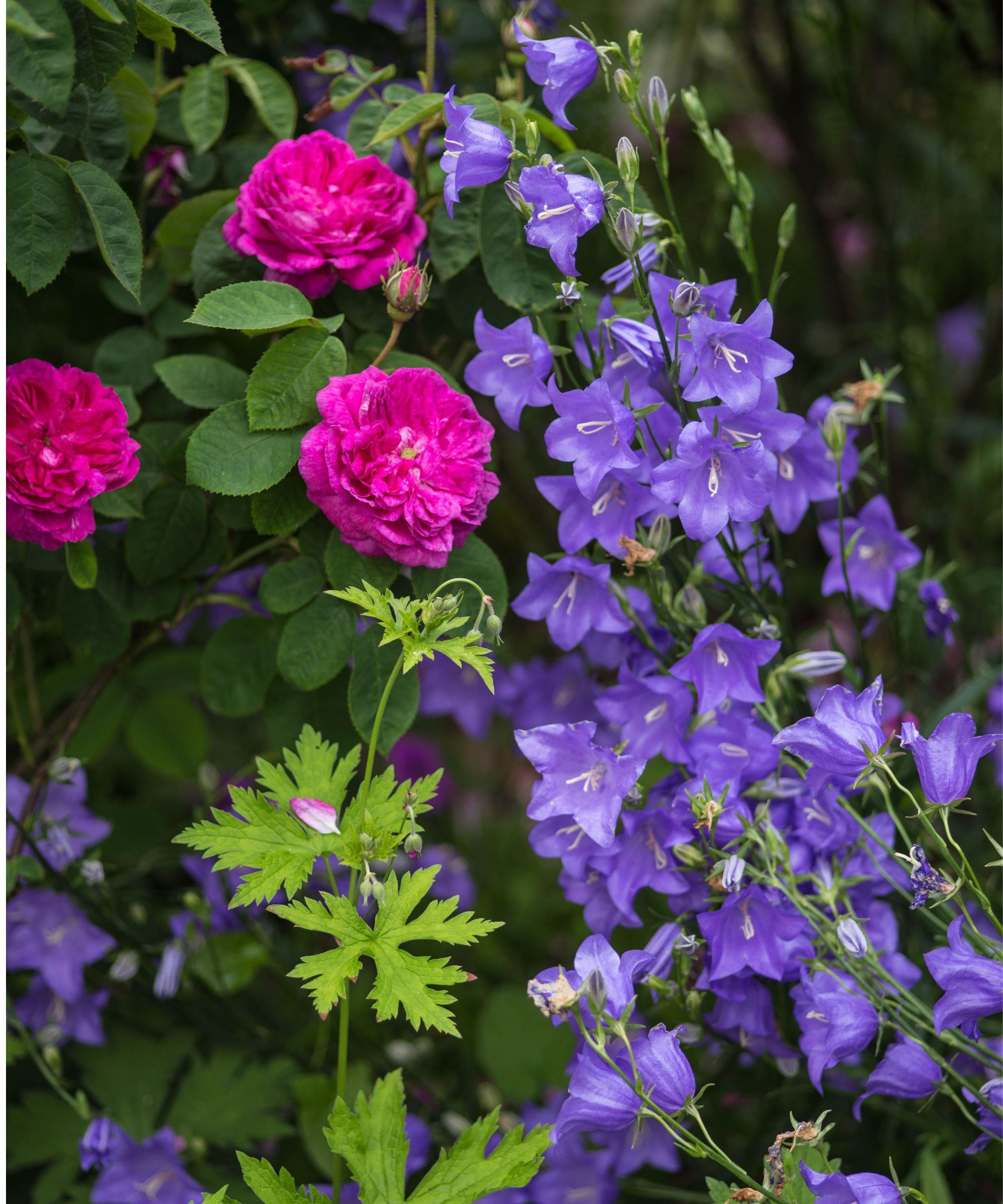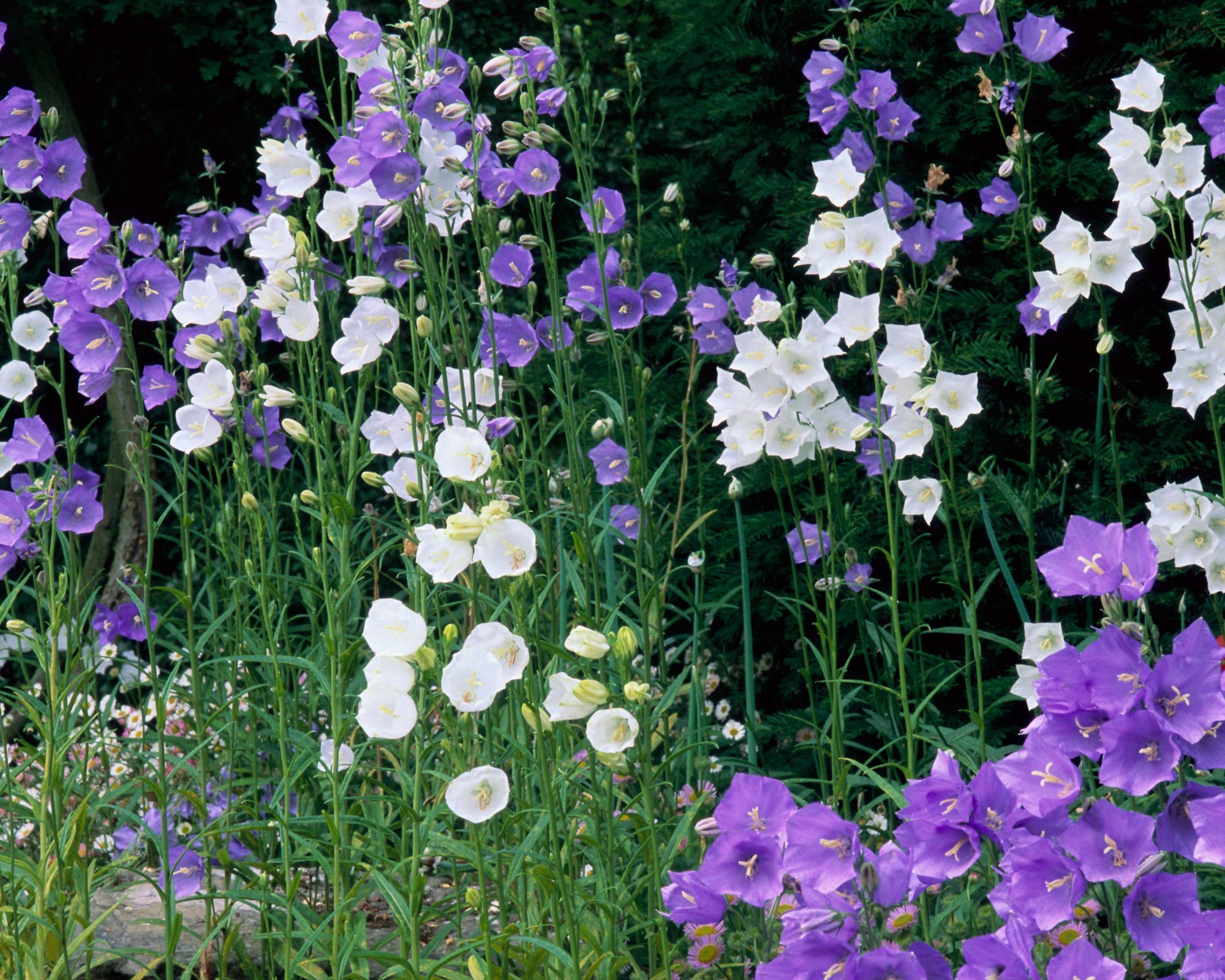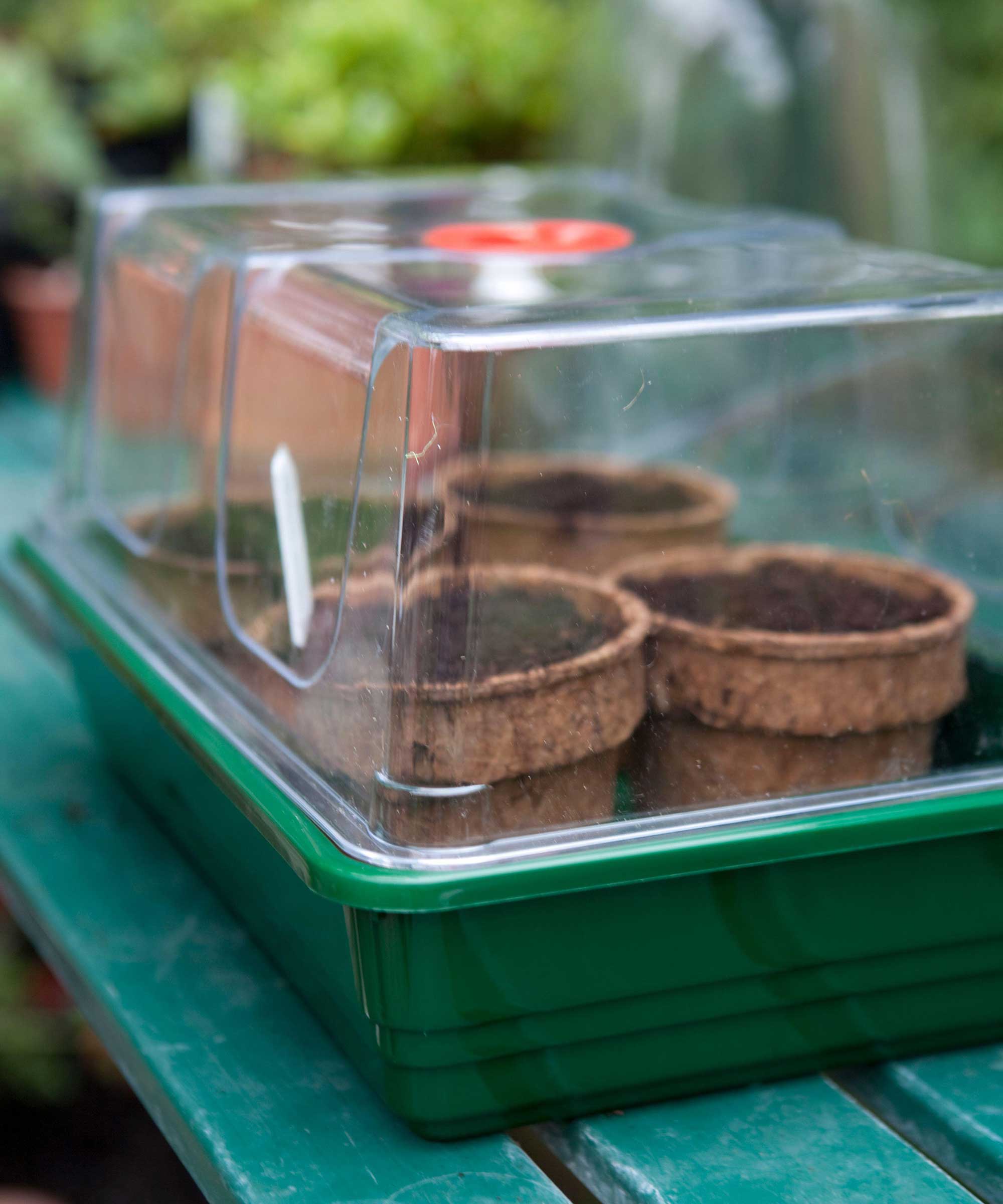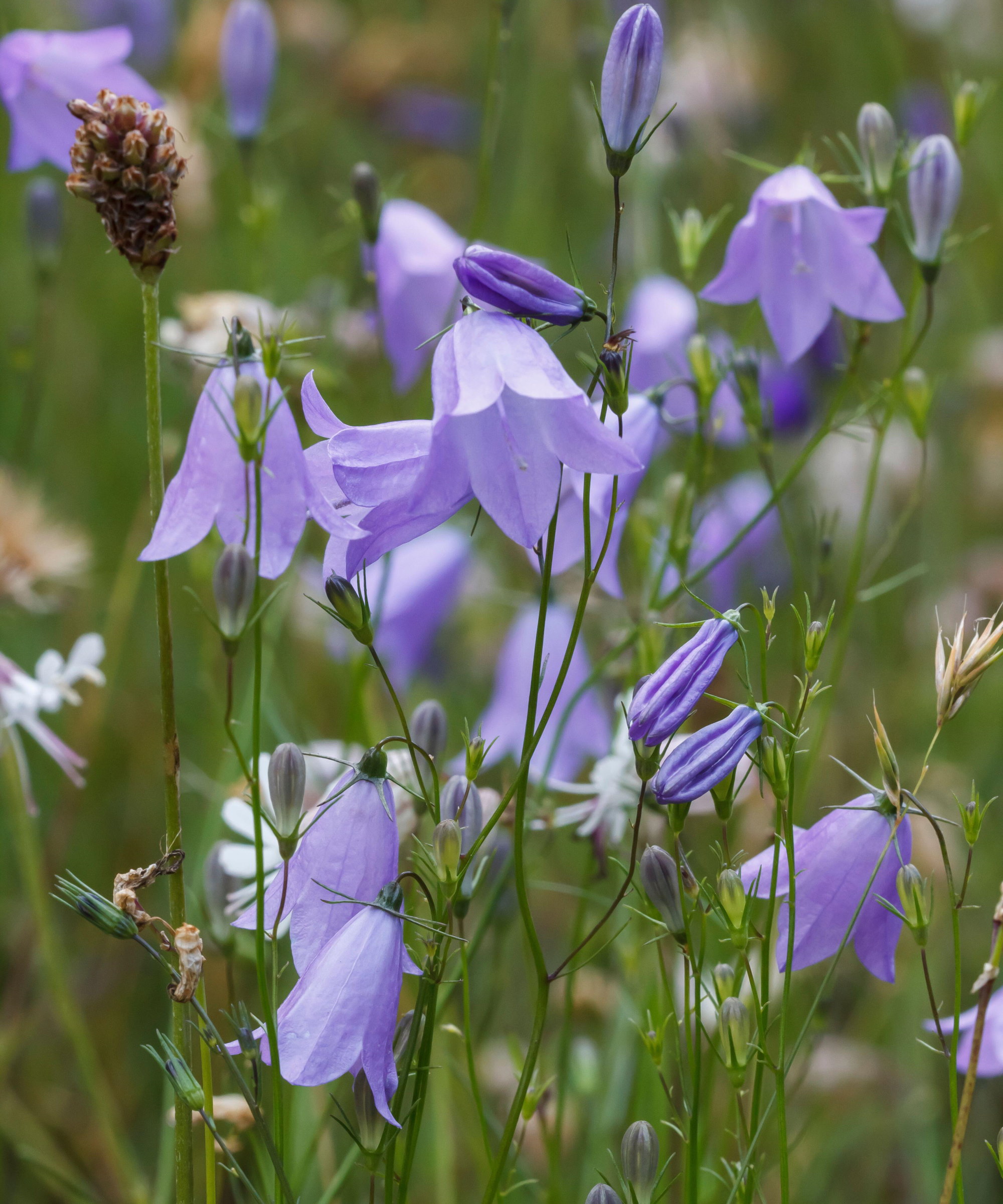
Bellflowers (also known as campanulas) have long been associated with cottage gardens, and for many of us, they are a non-negotiable for garden paths and naturalistic borders. They truly are a beautiful perennial and range in colors, from white to pale lilac to ballet slipper pink, but are most commonly seen in a regal violet-blue shade they have become famous for.
If, like me, you simply adore the sparks and lilts of floral interest that the cottage garden scheme offers, think swathes of scrambling roses, towering hollyhocks, lolling foxgloves, and borders aflutter with colorful butterflies and humming with bees, then campanula is a must-have perennial to add to your garden scheme.
Campanula is wonderfully easy to grow, self-seeds readily (which is marvellous, if you love that organic, blousy, untamed look), and flowers generously without very much upkeep at all, bar the occasional deadheading, naturally. Here, we look at how to grow campanula and help it thrive in your garden.

Where to grow campanula, and which varieties to grow
There are a few places in the garden where campanula looks beautiful and flourishes. Campanulas range in height and spread, so be sure that you're buying the right one for the growing spot you have in mind.
All campanulas are more than happy tolerating a good degree of shade, they're remarkably easy-going and will tolerate most spots in the garden. Happily, campanula requires very little attention and patience.
Once planted, they take off without hesitation. For some, their vigor can be a little startling, as they can be a little thuggish, but I tend to love their unwieldy shapes and any spot I have grown them in is always vastly enriched by their presence.
The main thing to remember is that campanulas like well-draining soil and don't like to be waterlogged.
Here are some ideas of where to plant different types of campanulas:
Campanulas look particularly magnificent on paving or steps. They spread with vigor through cracks and crevices and will provide a burst of color in even the most minute of gaps.
Trailing bellflower (Campanula poscharskyana), like this campanula available at White Flower Farm, is the best for this job. It's low-growing, spreads vigorously, and has masses of lilac star-shaped flowers held above a mat of deep green foliage. It blooms throughout summer and right into fall.
Trailing campanulas like this one can be grown in the most unlikely of spaces, through gaps in walls, cascading over the top of walls, and in between paving.
Campanulas also grow magnificently in borders, and being one of the best plants for pollinators, they're one to add to any wildlife-friendly border you're planning. For this, you want something that grows a little taller.
The giant bellflower (Campanula latifolia) reaches an incredible height of 3 ft. For something classic, go for the fairy bellflower (Campanula persicifolia), which is perhaps the most recognisable campanula and arguably the prettiest. It is that old-fashioned, chocolate-box cottage flower that we all adore.
How to grow campanula

Although these are low-maintenance plants, there are some things you can do to make your campanula grow healthily and flower for longer.
Most campanulas (apart from a small few) are perennial plants, so they come back year after year. To keep them coming back each year as beautiful and as floriferous as the previous year, there are a few simple things you can do to help them on their way.
Here's what you need to know to have happy and healthy campanulas in your garden:
- Before planting, ensure the soil is right for campanula. Campanula enjoys fertile soil, so it is worth enriching the soil with some compost or manure when you come to plant. Try using organic manure, like this manure available at Amazon. The soil must be well-drained to avoid root rot.
- I don't tend to fertilize campanula, but if you want to give them a boost, you can feed them in early spring with a generic organic plant food. An all-purpose fertilizer like this organic plant-based fertilizer available at Amazon, would help give it a super boost in nutrients. Campanulas don’t require a lot of food, and, in excess, it can make their stems floppy.
- Once planted, water thoroughly and then leave to grow. After the first thorough watering, you do not need to thoroughly water again; just a light watering will suffice. Overwatering poses more of a threat to campanula than underwatering.
- Deadhead campanula regularly throughout the growing season to prolong the flowering period. If you want the campanula to self-seed around your garden, then leave a few of the spent flowers on the plant, so the plant can form its seeds and send them off for delivery around your yard.
- Many campanulas can be lifted and divided every few years to make new plants and help them stay stronger for longer. I would leave it three to four years before doing this with young plants.
How to grow campanula from seed

Is it possible to grow campanula from seed? The short answer is yes, you can grow campanula from seed, and it is very easy to do so. The seeds are extremely small and will need sowing approximately ten weeks before spring.
Simply add your seeds to a seed-starting tray filled with moist potting mix, like this potting compost available at Amazon, cover, and pop in a warm location (remembering to keep them moist so they don't dry up).
Once your new little plants reach around 3-5 inches tall, you can plant them out into the garden. Plant out during milder months in spring or fall to avoid stress from extreme heat or cold. Seedlings don't usually bloom in their first year.
How to grow campanula from cuttings

Effective methods of propagating campanulas vary by species.
On the whole, though, the process is fairly similar. In early spring, following the very last frost, the campanula will throw out new green shoots. Pick a new green spring shoot that is emerging beside the original plant, and pick one that looks strong, healthy, and has several leaflets.
Using a clean knife (using a blunt, dirty knife for this process is one of the most common plant cutting mistakes people tend to make), slice through the shoot at the point between the root and the shoot with a single clean cut.
You can then plant this small cutting into compost (multi-purpose compost is perfect) into a small pot with drainage holes. Give it good water and ensure the soil always stays moist.
Place a plastic bag over the top of the pot to increase humidity around the cutting. In a few weeks, the plant will be strong and big enough to be planted out in the garden.
Campanula companion plants

When it comes to companion planting, campanula nearly always looks tumultuously romantic next to almost anything. Dog roses, honeysuckle, alliums, herbs like oregano or marjoram – gardening is much about serendipitous accidents, and campanula will often look most beautiful next to the most unlikely of plants. That said, here are some that always look tasteful next to bellflowers:
- Use a low-growing variety of campanula as an underplanting for roses. Campanula and roses will always be happy bedfellows.
- Use a taller upright form to add height to mixed borders and cottage-style gardens, alongside digitalis, thalictrum, nepeta, and loosestrife for a heady, blousy, cottage garden border.
- Use a smaller variety of campanula in a pot with other plants with similar growing needs, such as lobelia, geraniums, and for a full wildlife frenzy, add salvia to attract hummingbirds to your yard.
FAQs
Are campanula targeted by pests?
When grown in the right conditions, campanula is very resistant to pests and diseases. However, it's common to see aphids on campanula plants, which can be frustrating, but tend to pose little threat.
If you use organic neem oil, like this neem oil spray available at Amazon, you can stop aphids in their tracks.
How long do campanulas bloom?
The flowering period varies depending on the variety of campanula you are growing and the region you are growing it in. Usually, though, campanulas bloom for several months from mid-spring through to fall. Typically, June, July, and August are when they are at their most fantastic.
Can campanulas be grown in hanging baskets?
Yes, a trailing type would work best in a hanging basket. Those with a taller, upright form would not be suitable, nor would those ground-cover varieties, as they will spread staggeringly fast.
Instead, trailing campanulas, like the trailing bellflower Campanula portenschlagiana would do very well in hanging baskets. This type is easy and cheap to grow from seed indoors. Try these trailing bellflower seeds available at Amazon.
Shop campanula essentials
Don't forget to deadhead campanulas for a longer flowering period, and to help tidy up out of control trailing or spreading varieties. These snips are the best - they're super lightweight and extremely sharp.
Go easy on the fertilizing when it comes to campanulas, but if you want to fertilize in spring, do so with something like this bonemeal, which is proven to make roots far stronger.
For the most part, campanulas are not troubled by pests, but its likely the snails and slugs will give them a good munch if they possibly can. These Metaldyne free pellets will do the trick at keeping them away.
If you are going to plan a cottage garden, or already have one in place, you will want a succession of flowers, foliage, shapes and color to create your pastoral idyll. Campanulas or bellflowers should absolutely be on your roster; they will for sure have the desired effect.







